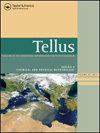瑞士少女峰铍- 7的控制因素
IF 2.3
4区 地球科学
Q3 METEOROLOGY & ATMOSPHERIC SCIENCES
Tellus Series B-Chemical and Physical Meteorology
Pub Date : 1999-09-01
DOI:10.1034/J.1600-0889.1999.T01-3-00004.X
引用次数: 57
摘要
1996年4月4日至1997年1月1日,在瑞士Jungfraujoch (JFJ)的高山研究站(07°59′e /46°32′n /3580 m asl)用伽马能谱法测量了be活度浓度,时间分辨率为2天。将这些数据与气象参数(对流层顶位势温度、相对湿度、JFJ位势温度)和瑞士东部阿罗萨的臭氧总量进行了分析。综合500 hPa位势高度图计算了7 Be活动浓度高和低的天数。研究发现,与高空脊和对流层顶高相关的向下输送是JFJ地区高7 Be活性浓度的重要控制机制。此外,湿扫也很重要。利用对流层顶位势温度和JFJ相对湿度作为预测因子的多元线性回归模型解释了研究期间7种Be活动浓度60%的变异。结果表明,平流层-对流层交换(STE)对JFJ 7 Be活度浓度的间接影响可能比直接影响更重要。平流层空气向JFJ的强烈向下输送可以认为是STE的直接影响,而平流层气团对流层年龄较长的多步输送过程可以认为是间接影响。研究了平流层-对流层交换的间接影响,其中,7月16日至23日在JFJ出现的最高7 Be浓度与北欧上空的平流层-对流层输送以及随后的下沉和强烈的南向平流有关。本文章由计算机程序翻译,如有差异,请以英文原文为准。
Factors controlling beryllium‐7 at Jungfraujoch in Switzerland
7Be activity concentrations were measured at the alpine research station at Jungfraujoch (JFJ), Switzerland, (07°59'E/46°32'N/3580 m asl) from 4 April 1996 to 1 January 1997 with a time resolution of 2 days using gamma spectroscopy. The data were analysed in relation to meteorological parameters (potential temperature at tropopause level, relative humidity, potential temperature at JFJ), and total ozone at Arosa in eastern Switzerland. Composite 500 hPa geopotential height maps were computed for days with high and low 7 Be activity concentrations. It was found that downward transport associated with an upper ridge and a high tropopause is a significant controlling mechanism for high 7 Be activity concentrations at JFJ. In addition, wet scavenging is also important. A multiple linear regression model using potential temperature at tropopause level and relative humidity at JFJ as predictors explained 60% of the variability in the 7 Be activity concentrations over the investigated period. The results indicate that the indirect influence of stratosphere-troposphere exchange (STE) to the 7 Be activity concentrations at JFJ may be more important than the direct one during the period under investigation. The vigorous downward transport of stratospheric air to JFJ may be considered as the direct influence from STE, whereas a multi-step transport process with a longer tropospheric age of the stratospheric air masses may be considered as the indirect one. The indirect influence of stratosphere-troposphere exchange is investigated in a case study in which the highest 7 Be concentration, occurring from 16 to 23 July at JFJ, is associated with stratosphere-troposphere transport above northern Europe and strong southward advection with subsequent subsidence.
求助全文
通过发布文献求助,成功后即可免费获取论文全文。
去求助
来源期刊
自引率
0.00%
发文量
3
期刊介绍:
Tellus B: Chemical and Physical Meteorology along with its sister journal Tellus A: Dynamic Meteorology and Oceanography, are the international, peer-reviewed journals of the International Meteorological Institute in Stockholm, an independent non-for-profit body integrated into the Department of Meteorology at the Faculty of Sciences of Stockholm University, Sweden. Aiming to promote the exchange of knowledge about meteorology from across a range of scientific sub-disciplines, the two journals serve an international community of researchers, policy makers, managers, media and the general public.

 求助内容:
求助内容: 应助结果提醒方式:
应助结果提醒方式:


